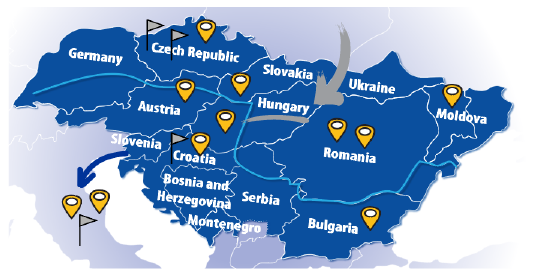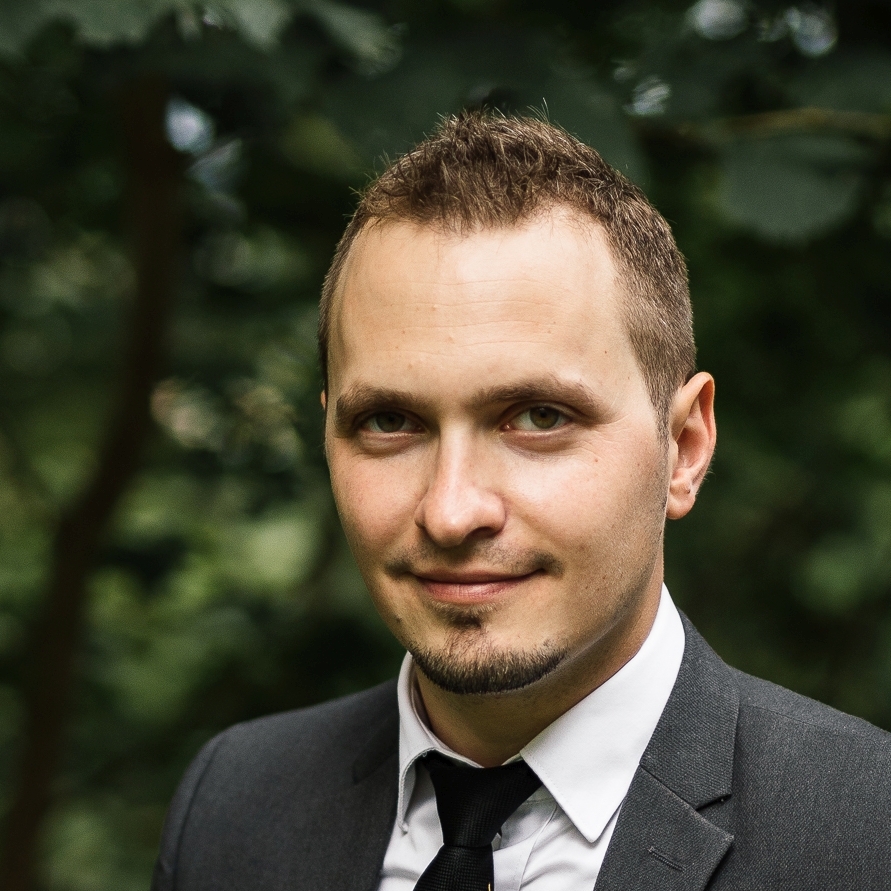SABRINA - Welcome to Hungary! – SABRINA Project Partner: West Pannon Team
16-12-2020
Isten hozott Magyarországon! – Welcome to Hungary!
Danube Transnational Programme covers 14 Danube area countries. In the SABRINA project, Hungary is represented by the West Pannon Regional and Economic Development Public Nonprofit Ltd. (West Pannon Team).
The West Pannon Team was established in 2011 and is a non-profit organization from the West Transdanubia region of Hungary (a statistical region in western Hungary – on the border with Austria and Slovenia), committed to the development of sustainable transport. Their mission is to support the initiation and implementation of cooperation-based regional and economic development processes in their region. It is based on local community-building, as well as national and international network cooperation. The aim of the Westpannon Team is to strengthen networking among the region’s municipalities, enterprises, and non-governmental organizations at sub-regional, county, and regional levels, increasing the efficiency of development programs and improving the effectiveness of their implementation. They have been involved in several transnational initiatives including projects related to sustainable mobility and cycling.

We have talked with Zsombor Aradszki, Project Manager of transnational cooperation projects at the West Pannon Team, about their role in the SABRINA project and cycling challenges and opportunities in Hungary.
The West Pannon Team has a lot of experience with international projects which have cycling and sustainable mobility in their core. How is the SABRINA project different? What will the West Pannon Team bring to the project and what will in your opinion be the positive effects of the project for Hungary?
The West Pannon Nonprofit Ltd. was founded to support the West Transdanubia region’s sustainable development relying on cooperation, expertise, and the values of nature and culture. I joined the team six years ago and started my journey with transnational and interregional cooperation projects including topics like nature-based economic development, intangible cultural heritage, and, of course, sustainable mobility initiatives. Regarding the latter, my colleagues and I have worked on European Union and Hungarian State-funded projects covering several aspects. If we look at sustainable tourism, West Pannon Team coordinated the Iron Curtain Trail project, involving 15 southeast European partner organizations from Greece to Slovakia intended to interconnect the cycling networks of the Iron Curtain Trail along the border regions. Also, with the Transdanube, Trasndanube Pearls, and now with the Transdanube Travel Stories projects, we are implementing innovative promotion concepts and sustainable mobility management tools in the Danube region. Still talking about tourism, in the frame of the Amazon of Europe Bike Trail and Amazing Amazon of Europe we have started to establish an internationally recognized and sustainable flagship cycling tourism product in the future 5-country UNESCO Biosphere Reserve Mura-Drava-Danube. In terms of developing policy aspects of cycling, we are the lead partner of the project EU CYCLE (Interreg Europe) that aims to improve the quality of cycling projects in the next programming period - we work together with several European partners, including the European Cyclists’ Federation as an advisory partner in this project.
Of course, implementation of these initiatives requires a vast network of cooperative stakeholders, not only on an international level but also within our own region. We are lucky to be able to maintain a good relationship with local people, local entrepreneurs, and different innovative public organizations, such as the GYSEV Győr-Sopron-Ebenfurth Railway, a regional train company that is devoted to developing and promoting sustainable transport and tourism. Moreover, we should not forget that all these initiatives need national-level support: we are grateful for the co-operative attitude of our line ministries and background institutions; we can always count on them.
We could say it is quite an impressive list, but the question may arise, what do they have in common besides their general topic. During the years of implementation, we have realized there has been an always recurring topic: safety! Without putting safety into the foreground, how could we talk about any kind of development? Without thinking about the physical safety of cyclists, how could we talk about promotion? We can say, this is the reason why we are so happy for being involved in a project like SABRINA, which provides an ‘umbrella’ for our sustainable transport projects and focuses on the safety of cycling infrastructure.
One of the main activities in the SABRINA project is to inspect the long-distance EuroVelo routes for safety. The plan is to inspect more than 700 km of four EuroVelo routes in Hungary (no. 6, 11, 13, and 14). For the SABRINA Kick-off conference, you have prepared a great video (available HERE) about part of EuroVelo 13 – The Iron Curtain Trail and pointed out some cycling infrastructure challenges. Where do you think the biggest improvements are possible in this regard?
 West Transdanubia is embraced by the EuroVelo 6, 13, and 14 routes. Also, after consultation with the Ministry for Innovation and Technology, the Hungarian Public Road Nonprofit PLC (responsible for the operation and maintenance of national road network), and the Centre for Development of Active and Ecotourism (AÖFK) we have decided to include also EuroVelo 11 in the inspection process. Even though it is quite far from our direct area, we think that we should not limit ourselves only to our region. Although Hungarian sections are the results of a careful and thoughtful planning process, as you can see in our video, there are still several sub-sections that contain or may contain dangerous stages and parts according to informal information from stakeholders and citizens, which is not reliable nor verified by duly substantiated data. By star-rating which will be done in the framework of the SABRINA project, the pre-defined routes in the region, official, relevant, and transnationally comparable data will be available. Besides, developing a strategic decision-making toolkit relying on the best practices related to cycling infrastructure and safety improvement measures, practical solutions for the identified bottlenecks will also be provided. These two elements are essential to support well-targeted decision-making to remove bottlenecks in key network infrastructure and to cope with the previously mentioned challenges.
West Transdanubia is embraced by the EuroVelo 6, 13, and 14 routes. Also, after consultation with the Ministry for Innovation and Technology, the Hungarian Public Road Nonprofit PLC (responsible for the operation and maintenance of national road network), and the Centre for Development of Active and Ecotourism (AÖFK) we have decided to include also EuroVelo 11 in the inspection process. Even though it is quite far from our direct area, we think that we should not limit ourselves only to our region. Although Hungarian sections are the results of a careful and thoughtful planning process, as you can see in our video, there are still several sub-sections that contain or may contain dangerous stages and parts according to informal information from stakeholders and citizens, which is not reliable nor verified by duly substantiated data. By star-rating which will be done in the framework of the SABRINA project, the pre-defined routes in the region, official, relevant, and transnationally comparable data will be available. Besides, developing a strategic decision-making toolkit relying on the best practices related to cycling infrastructure and safety improvement measures, practical solutions for the identified bottlenecks will also be provided. These two elements are essential to support well-targeted decision-making to remove bottlenecks in key network infrastructure and to cope with the previously mentioned challenges.
The Covid-19 pandemic has boosted cycling in many places around the world and especially in Europe. Even in the pre-Covid-19 era, according to a Eurobarometer survey, more than 20% of interviewed Hungarians said that on a typical day the mode of transport they use the most often is a bicycle. This positions Hungary only behind Denmark and The Netherlands which are typically known as cycling nations. Does the flat topography of those countries have something to do with that? Would you say people in Hungary bike more in the cities or also outside of the urban areas?
If you look at a recent survey (note: in Hungarian) carried out by the Hungarian Cyclists' Club, you will see that it definitely has something to do with the topography, at least in Hungary. While the share of people using a bicycle as the main transport mode is around 10% in the counties lying in the territory of the Hungarian Mountain Range, this number goes up to 25–35% in the counties of the Great Hungarian Plain. In this regard, it will be interesting to see what will happen in the next ten years with the rise of e-mobility, which is also promoted by the Hungarian government: the Ministry of Innovation and Technology is providing a total of HUF 1 billion (EUR 2.8m) in support for the purchase of e-bikes (source in English here).
To answer your second question, I would like to quote again the survey mentioned above, which says that smaller towns and villages have a higher proportion of cyclists – this is most likely to be related to the length of journeys and the volume of car traffic.
The Centre for Development of Active and Ecotourism (AÖFK) and the Hungarian road maintenance public company Magyar Közút published a report (note: in Hungarian) on the development of cycling tourism in 2020 summer in Hungary. The increase in the number of cyclists was huge. Especially, around the big Hungarian lakes on EuroVelo routes 11, 13, and 14. The fact is there were some infrastructure improvements carried out and some cycling networks finished. What is in your opinion a key factor for active and sustainable tourism and mobility?
Indeed, this rapid increase was amongst the few positive impacts brought by the Covid-19 pandemic. We have to point out that large Hungarian lakes, Lake Fertő/Neusiedl on EuroVelo 13 – Iron Curtain Trail, Lake Tisza on EuroVelo 11 – East Europe Route, Lake Velence and Lake Balaton on EuroVelo 14 – Waters of Central Europe have better infrastructure conditions for cyclists in general, of course, besides the recent developments. Also, leisure activities have been changed dramatically by the current situation: what is one of the most obvious forms of active leisure activities that fit social distancing? Putting these two factors together gives you an explanation of the rapid growth in the number of cyclists around the lakes. But be careful, as this line of reasoning can lead to the erroneous conclusion that infrastructure development is the key factor for active and sustainable tourism and mobility. Of course, it plays a great role, and financially it is the most burdensome aspect, but, based on my experience and results of numerous surveys, the most important factor is the improvement in terms of safety that is brought by well-designed infrastructure developments. Still, we know that infrastructure development is not the only way to improve safety! I can only say that we will be working as hard as we can to support safety-related measures to improve the conditions for cyclists and cycling-related developments. Therefore, we are very happy to be part of the SABRINA project team. Let’s ride the wave of cycling popularity!



